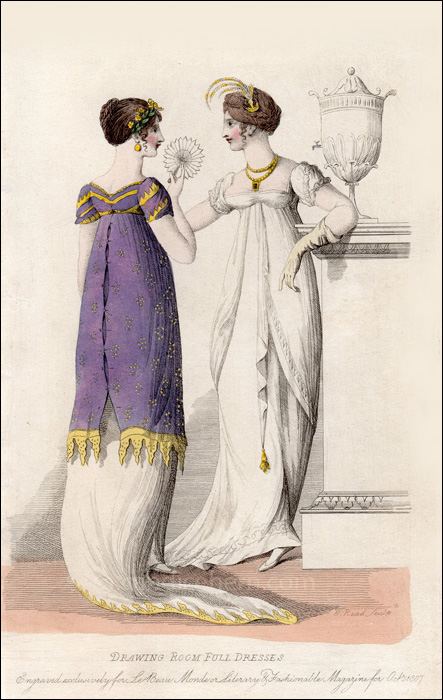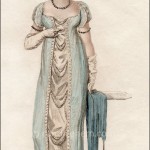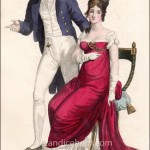Le Beau Monde, October 1807.
“Drawing Room Full Dresses.”
 Despite the print title, these elegant evening dresses were not meant to be worn at a formal court Drawing Room, eg in honor of the King’s or Queen’s birthday. Full court dress would have been worn for those occasions. These dresses would have been worn at some other elegant, likely aristocratic drawing room party.
Despite the print title, these elegant evening dresses were not meant to be worn at a formal court Drawing Room, eg in honor of the King’s or Queen’s birthday. Full court dress would have been worn for those occasions. These dresses would have been worn at some other elegant, likely aristocratic drawing room party.
The print is described in the magazine as follows:
“Fig. No. 3–An elegant Livonia Dress, made of purple bloom soft satin, sprigged with small clusters of gold dots; the dress to fall a little below the knees, with rich gold bullion trimming in the form of a Vandyke; the back part gored off to the shape, with a cottage front, confined with gold buttons down the skirt; sleeves short and low on the shoulders, with a narrow trimming to accompany the bottom of the dress, worn round the arm in the form of a cork-screw, to give it the appearance of genteel confinement; a white lace train petticoat is worn under this dress, with a rich border of Vandyke worked with a light gold thread to correspond. Headdress quite plain, entirely of hair, combed strait over the head, from the front of the forehead, plaited in a thick cable plait, brought up to the crown of the head, turned under and fastened with a brilliant comb. The hair à-la-Madona on each side of the forehead, with a long cork-screw curl on the right side of the face: a rich half-wreath of green enamelled stone, intermixed with small gold flowers ornaments the right side of the head. Ear-rings of thick gold; gloves of white lace; shoes of purple satin; fan, ivory and silver.
“Fig. No. 4–The Rutland Half Robe, composed of a beautiful fine Indian muslin, in three different lengths, the first is made apparently loose, caught up in the center of the waist, and continues to fall in loose draperies down the front, and fastened at the end with a rich gold tassel; the second and third lengths are combined into one, and are finished into an immense length, which descends from the waist, ornamented round the bottom, and draperies with a rich border of point lace, stamped with small white satin flowers; the back and front of the dress are made low and square, and drawn down at each corner of the bosom; sleeves are quite short, so as only to cover the top of the shoulder; made very full at the back part of the shoulder, and tight across the front, with a thick rope of lace and satin intermixed, which is confined round the arm, and continued across the front of the arm to the top of the shoulder. A superb head-dress of hair. The hair is long behind, combed straight up, and fastened in different forms round the head, with small Egyptian combs of gold. The hair is brought straight from a small clustre of hair on the front of the forehead, round the left side of the head, with a small ringlet of hair down the side of the face. A Bird of Paradise of gold set in a half-moon, fastened in the thick part of the hair, drooping over the face. A brilliant necklace of rich gold, from whence descends and Egyptian amulet; gloves straw coloured and shoes white satin.”
Though the artist of this beautiful print is unknown, the engraver included his name: William Read, a popular engraver from the early 19th century through the 1840s.







